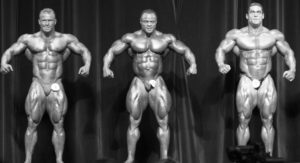
By Strength Sensei CP
Publication Date: 1996
The typical male superhero has wide, thick shoulders. While preparing for the role as Superman, Christopher Reeve underwent a strenuous weight training program that emphasized shoulder width to produce that much-admired V-taper. David Prowse, the weightlifter who trained Reeve for the role, said he had the actor do minimal chest and trapezius work so as not to detract from his delt development. The strategy was to make our Man of Steel look more like a gymnast than a bodybuilder. It worked, and Reeve’s Superman movies inspired many of us to “Fight for Truth, Justice, and the American Way” or, at least, do a few extra sets of delt work.
For bodybuilders, interest in shoulder development seems to come only after a long period of chest work. The chest muscles develop quickly from the over-reliance on bench pressing, so it’s common to at least a dozen rookie bodybuilders in ever gym whose misguided training methods make them look like they have breasts instead of pecs.
When I train bodybuilders, the first thing I do is look for the weak points in their physiques. Then I develop a short-term plan to address these weak points, usually four weeks for beginners and six weeks for experienced bodybuilders. On this point, although Tom Platz’s freaky legs helped him place third in the 1981 Mr. Olympia, he would have had a more symmetrical physique (and might even have won the competition) if he had focused less on his legs and more on his upper body.
Balanced development is also important because often a body part looks small when adjacent muscle groups are small. For example, increasing the size of your calves will give the illusion that your thighs are bigger. (This effect also works in reverse – women wear high heels so their calves and thighs look smaller.) In addition to making the waist look smaller, having well-developed deltoids makes the arms look bigger as you get more of a “3D look.”
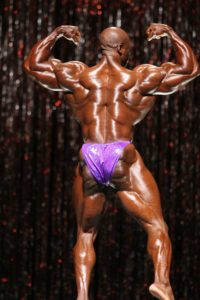
Pro bodybuilders spend a considerable amount of time developing 3D shoulders that look good from all angles. (Lead photo and this photo by Miloš Šarčev)
The Keys to Shoulder Girth
Wide shoulders are a result of the amount of muscle mass you possess and the length of the bones of your shoulders, which is technically referred to as the biacromial breadth. By the time you reach 21, your shoulder bones will be about as wide as they’re going to get, and there’s probably nothing you can do to influence their growth beyond what will be obtained by having a diet that contains adequate amounts of calcium. Although there is speculation that weight training can increase bone length, I haven’t seen any convincing studies on this subject.
Although there’s nothing you can do to increase your bi-acromial breadth, there are ways (other than malnutrition) to decrease it. Taking anabolic steroids before age 21 may take away some of the growth potential, because steroids can prematurely close the growth plates located in the bones. Injuries that occur from improperly-designed workouts could damage the growth plates; however, such injuries are rare, and in my opinion, many doctors and other medical professionals who don’t understand weight training often overreact. After all, many weightlifters start training in pre-pubescence, especially in European countries, without suffering from these effects. Furthermore, the studies available on this subject conclude that two of the major causes of such injuries are poor lifting techniques and use of excessively heavy weights. For more on this subject, and on other injuries that youngsters who lift weights could incur, I recommend Designing Resistance Training Programsby Steven Fleck and Williams Kraemer.
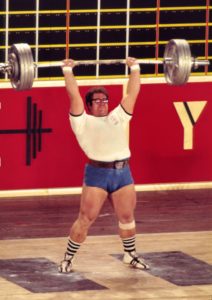
The Olympic press was dropped from weightlifting competition in 1972. Ken Patera became the first and only American to clean and press 500 pounds and later become a professional wrestler. (Bruce Klemens photo)
The second factor to consider in widening the shoulders, and the one that is more under your control, is muscle growth. The deltoid is a muscle group with three heads, anterior (front), lateral (side), and posterior (rear). To achieve that melon-like deltoid shape, you need to develop each head equally. Let’s start by taking a closer look at what most strength training (and self-proclaimed) experts consider the most basic shoulder exercise – the military press.
A Pressing Question
The military press is a tremendous shoulder exercise for all levels of bodybuilders. Because your elbows are flared out during the exercise, most of the work is performed by the lateral head of the deltoids; the anterior deltoid works only at the beginning of the movement. The military press is also an excellent exercise for the serratus anterior because it pushes the shoulder blades apart. By the way, you’re wasting your time if you do pullovers to work your serratus anterior – pullovers work the muscles antagonistic to this muscle group.
Many bodybuilders don’t perform either the military press or the behind-the-neck press because they say these exercises hurt their shoulders. The typical scenario is that they start with the behind-the-neck press; when that exercise becomes too painful, they switch to front presses, incline presses, and finally the bench press. Eventually, even the bench press causes pain, and they are forced to regress to a geek routine of lateral raises.
There are several reasons the shoulder can become injured from overhead presses. The first is a lack of attention to training the external rotators (the group of muscles that rotate the arm so the thumb points away from you) of the humerus (the long bone of the upper arm). These muscles need special attention to prevent injury. According to soft tissue expert Dr. Mike Leahy, a muscle imbalance between the prime movers of the shoulders and the external rotators is one of the major causes of shoulder injury. Although it means setting aside your ego and performing exercises that don’t allow you to use heavy weights, a few minutes a week performing exercises for the external rotators will do wonders for preventing chronic shoulder problems.
If bodybuilders don’t perform enough work for their upper back muscles, particularly those that help support the spine, they develop a humpback appearance that is more appropriate for apes. This type of posture puts considerable stress on the shoulder capsule when they perform behind-the-neck presses, a stress that can eventually cause permanent instability in the joint. This stress can also affect an upper back muscle called the levator scapulae that, when strained, is responsible for causing that chronic “crick” in your neck that makes it painful to turn your head. So it’s not that the behind-the-neck press is such a bad exercise, but you have to have good posture to be able to perform it correctly and comfortably.
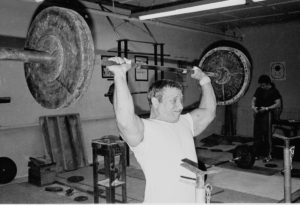
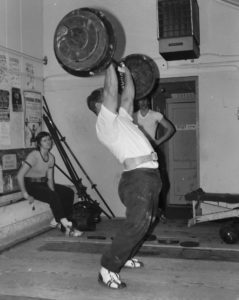
Phil Grippaldi broke many American records in the Olympic press, with a best of 402 pounds at a bodyweight of 198 pounds! This 3x Olympian is shown performing behind-the-neck presses and the Olympic press. (Bruce Klemens photo)
Another problem with overhead presses is that most bodybuilders don’t know how to do them correctly. The most common technical fault is not performing the exercise throughout a full range of motion; many lifters lower the weight just to ear level. Although you will acquire considerable triceps development out of this practice, you will get little in terms of shoulder development, and this technique may contribute to the development of postural problems that can eventually lead to injury.
Tips on Shoulder Workout Design
Unless you are a powerlifter or weightlifter, there is no need to perform any isolation work for the anterior deltoid with exercises such as the front dumbbell raise. The anterior delts usually develop more than enough from the high volume of chest work that most bodybuilders perform, such that additional work will probably result in overtraining. What most trainees need is to work very hard on exercises for the lateral and posterior heads of the deltoids.
Regardless of the exercises performed, one of the most confusing aspects of designing a shoulder workout is determining how many sets and reps to perform. Powerlifters and weightlifters have built impressive shoulders using low reps for multiple sets. In contrast, there are plenty of bodybuilders who have achieved fantastic deltoid development by concentrating on high reps for fewer sets. I believe that the best approach is a combination of both methods, which means you’d perform periods of high reps, alternated with periods of lower reps.
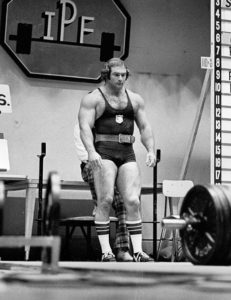
Powerlifters often perform a variety of pressing exercises that produce impressive shoulder development. Shown is Doug Young, a massively-built powerlifter who won three IPF World Championships (1975-77) and who bench pressed 612 pounds in T-shirt. (Bruce Klemens photo)
If you are willing to commit to a shoulder specialization program, you will have to cut back on the amount of work you devote to other body parts, particularly the chest muscles. And for maximum results, you should train your shoulders first in a training session.
You will never be able to run faster than a speeding bullet or leap tall buildings with a single bound, but by training your shoulders hard and training them smart, you can certainly develop a super physique!
